Virtual Deformable Image Sensors: Towards to a General Framework for Image Sensors with Flexible Grids and Forms
Abstract
:1. Introduction
- (a)
- (b)
- The grid and pixel are hexagonal and square respectively and there is no or fixed gap in [29], where the hexagonal grid is generated by a half-pixel shifting, its results show that the generated hexagonal images are superior in detection of curvature edges to the square images.
- (c)
- The grid and pixel are hexagonal and there is no gap [30]. In this work, the impact of the three sensor properties, the grid structure, pixel form and fill factor, is examined by curviness quantification using gradient computation. The results show that the grid structure and pixel form are the first and second most important properties and the hexagonal image is the best image type for distinguishing the contours in the images.In this study we pay attention to two new configurations:
- (d)
- The grid and pixel are hexagonal and there is a fixed gap;
- (e)
- The grid and pixel are Penrose and there is no or fixed gap. In this paper, the feature descriptor, histogram of oriented gradient (HoG), is used for examining the impact of the above two configurations to obtain the characteristics of the sensor structure.
2. Virtual Deformable Image Sensor
2.1. Hexagonal Tiling
2.2. Penrose Pixel Arrangment
3. Image Generation on Deformable Grid
- (a)
- A grid of virtual image sensor pixels is constructed. Each original pixel, having square pixel form and arranged in square grid is projected onto a grid of × square subpixels. According to the configuration size of the gap between the pixels, the size of the active pixel area is defined as , where . The intensity value of every pixel in the image sensor array is assigned to the virtual active pixel area in the new grid. The intensities of subpixels in the gap areas are assigned to be zero. An example of such sensor rearrangement on sub-pixel level is presented in Figure 6, where there is a 3 by 3 pixels’ grid, and the light and dark grey areas represent the active pixel areas and the gap areas. Assuming and , and thereby the gap size becomes according to the above equation.
- (b)
- The second step is to estimate the values of subpixels in both pixel areas and gap areas. Considering the statistical fluctuation of incident photons and their conversion to electrons on the sensor is a random Gaussian process, from a certain neighborhood area of each pixel, a local Gaussian model is generated by maximum likelihood method. Then a local noise source is generated within each local model, and introduced to its certain neighborhood. Inspired by Monte Carlo simulation, all subpixels in each certain neighborhood are estimated in an iteration process using the known pixel values (for subpixels in the active pixel area) or by linear polynomial reconstruction (for subpixels in gap area). In each iteration step the number of subpixels in the pixel area is varied from zero to total number of subpixels in pixel area. After the iteration process, a vector of intensity values for each subpixel is generated and the final subpixel value is predicted using Bayesian inference method and maximum likelihood of Gaussian distribution.
- (c)
- In the third step, the subpixels are projected onto the new deformable sensor grid with different sensor grid, pixel form and gap size in respective configuration proposed in Section 2. In this paper, three sets of configurations are considered: (1) square grid and pixel form with or without gap; (2) pseudo-hexagonal grid by half-square-pixel shift and square pixel form with or without gap; (3) hexagonal grid and pixel form with or without gap; and (4) Penrose grid and rhombus pixel form with or without gap, where each of the configurations deformability is demonstrated. For the image generation in the different grids, the subpixels are projected back onto the new sensor grid. The intensity value of each pixel in different sets of configurations is the intensity value which has the strongest contribution in the histogram of its belonging subpixels.
4. Implementing Histogram of Gradient in Different Configurations
5. Experimental Setup
6. Results and Discussion
7. Conclusions
Author Contributions
Conflicts of Interest
References
- OmniVision Technologies Inc. OV5675, Color CMOS 5-Megapixel (2592 × 1944) PureCel® Image Sensor. Available online: http://www.ovt.com/sensors/OV5675 (accessed on 26 May 2018).
- Chen, T.; Catrysse, P.B.; El Gamal, A.; Wandell, B.A. How small should pixel size be. In Electronic Imaging; International Society for Optics and Photonics: Bellingham, WA, USA, 2000; pp. 451–459. [Google Scholar]
- Fossum, E. The quanta image sensor (QIS): Concepts and challenges. In Computational Optical Sensing and Imaging; Optical Society of America: Washington, DC, USA, 2011; p. JTuE1. [Google Scholar]
- Fossum, E.R.; Ma, J.; Masoodian, S.; Anzagira, L.; Zizza, R. The quanta image sensor: Every photon counts. Sensors 2016, 16, 1260. [Google Scholar] [CrossRef] [PubMed]
- Chan, S.H.; Elgendy, O.A.; Wang, X. Images from bits: Non-iterative image reconstruction for quanta image sensors. Sensors 2016, 16, 1961. [Google Scholar] [CrossRef] [PubMed]
- Lamb, T.D. Evolution of phototransduction, vertebrate photoreceptors and retina. Prog. Retin. Eye Res. 2013, 36, 52–119. [Google Scholar] [CrossRef] [PubMed]
- Sugathan, S.; James, A.P. Irregular pixel imaging. In Proceedings of the 2014 International Conference on Advances in Computing, Communications and Informatics (ICACCI), Delhi, India, 24–27 September 2014; pp. 2459–2463. [Google Scholar]
- Curcio, C.A.; Sloan, K.R.; Kalina, R.E.; Hendrickson, A.E. Human photoreceptor topography. J. Comp. Neurol. 1990, 292, 497–523. [Google Scholar] [CrossRef] [PubMed]
- Mustafi, D.; Engel, A.H.; Palczewski, K. Structure of cone photoreceptors. Prog. Retin. Eye Res. 2009, 28, 289–302. [Google Scholar] [CrossRef] [PubMed] [Green Version]
- Tam, N.D. Hexagonal pixel-array for efficient spatial computation for motion-detection pre-processing of visual scenes. Adv. Image Video Process. 2014, 2, 26–36. [Google Scholar] [CrossRef] [Green Version]
- Asharindavida, F.; Hundewale, N.; Aljahdali, S. Study on Hexagonal Grid in Image Processing. In Proceedings of the International Conference on Information and Knowledge Management, Kuala Lumpur, Malaysia, 24–26 July 2012. [Google Scholar]
- Coleman, S.; Gardiner, B.; Scotney, B. Adaptive tri-direction edge detection operators based on the spiral architecture. In Proceedings of the 2010 17th IEEE International Conference on Image Processing (ICIP), Hong Kong, China, 26–29 September 2010; pp. 1961–1964. [Google Scholar]
- Jiang, Z.T.; Xiao, Q.H.; Zhu, L.H. 3D reconstruction based on hexagonal pixel’s dense stereo matching. Appl. Mech. Mater. 2010, 20–23, 487–492. [Google Scholar] [CrossRef]
- Schweng, D.; Spaeth, S. Hexagonal Color Pixel Structure with White Pixels. U.S. Patent 7,400,332B2, 15 July 2008. [Google Scholar]
- Fukushima, K.; Yamaguchi, Y.; Yasuda, M.; Nagata, S. An electronic model of the retina. Proc. IEEE 1970, 58, 1950–1951. [Google Scholar] [CrossRef]
- Mead, C.A.; Mahowald, M.A. A silicon model of early visual processing. Neural Netw. 1988, 1, 91–97. [Google Scholar] [CrossRef] [Green Version]
- Boahen, K.A.; Andreou, A.G. A contrast sensitive silicon retina with reciprocal synapses. In Advances in Neural Information Processing Systems; MIT Press: Cambridge, MA, USA, 1992; pp. 764–772. [Google Scholar]
- Andreou, A.G.; Boahen, K.A. A 48,000 pixel, 590,000 transistor silicon retina in current-mode subthreshold CMOS. In Proceedings of the 37th Midwest Symposium on Circuits and Systems, Lafayette, LA, USA, 3–5 August 1994; Volume 1, pp. 97–102. [Google Scholar]
- Gardner, M. Mathematical Games. Sci. Am. 1980, 243, 18–28. [Google Scholar] [CrossRef]
- Iñigo, R.; McVey, E.S.; Hsin, C.; Rahman, Z.; Minnix, J. A New Sensor for machine vision. IFAC Proc. Vol. 1986, 19, 81–86. [Google Scholar] [CrossRef]
- Her, I.; Yuan, C.-T. Resampling on a pseudohexagonal grid. CVGIP Graph. Models Image Process. 1994, 56, 336–347. [Google Scholar] [CrossRef]
- Van De Ville, D.; Philips, W.; Lemahieu, I. Least-squares spline resampling to a hexagonal lattice. Signal Process. Image Commun. 2002, 17, 393–408. [Google Scholar] [CrossRef]
- Li, X.; Gardiner, B.; Coleman, S.A. Square to Hexagonal lattice Conversion in the Frequency Domain. In Proceedings of the 2017 International Conference on Image Processing, Beijing, China, 17–20 September 2017. [Google Scholar]
- Ben-Ezra, M.; Lin, Z.; Wilburn, B.; Zhang, W. Penrose Pixels for Super-Resolution. IEEE Trans. Pattern Anal. Mach. Intell. 2011, 33, 1370–1383. [Google Scholar] [CrossRef] [PubMed] [Green Version]
- Ben-Ezra, M.; Lin, Z.; Wilburn, B. Penrose pixels super-resolution in the detector layout domain. In Proceedings of the IEEE 11th International Conference on Computer Vision (ICCV 2007), Rio de Janeiro, Brazil, 14–21 October 2007; pp. 1–8. [Google Scholar]
- Wen, W.; Khatibi, S. Novel Software-Based Method to Widen Dynamic Range of CCD Sensor Images. In Proceedings of the 8th International Conference on Image and Graphics, Tianjin, China, 13–16 August 2015; pp. 572–583. [Google Scholar]
- Wen, W.; Khatibi, S. A software method to extend tonal levels and widen tonal range of CCD sensor images. In Proceedings of the 2015 9th International Conference on Signal Processing and Communication Systems (ICSPCS), Cairns, QLD, Australia, 14–16 December 2015; pp. 1–6. [Google Scholar]
- Wen, W.; Khatibi, S. Estimation of Image Sensor Fill Factor Using a Single Arbitrary Image. Sensors 2017, 17, 620. [Google Scholar] [CrossRef] [PubMed]
- Wen, W.; Khatibi, S. Back to basics: Towards novel computation and arrangement of spatial sensory in images. Acta Polytech. 2016, 56, 409–416. [Google Scholar] [CrossRef]
- Wen, W.; Khatibi, S. The Impact of Curviness on Four Different Image Sensor Forms and Structures. Sensors 2018, 18, 429. [Google Scholar] [CrossRef] [PubMed]
- Woog, K.; Legras, R. Visual resolution and cone spacing in the nasal and inferior retina. Ophthalmic Physiol. Opt. 2018, 38, 66–75. [Google Scholar] [CrossRef] [PubMed]
- Horn, B. Robot Vision; MIT Press: Cambridge, MA, USA, 1986. [Google Scholar]
- Coleman, S.; Scotney, B.; Gardiner, B. Tri-directional gradient operators for hexagonal image processing. J. Vis. Commun. Image Represent. 2016, 38, 614–626. [Google Scholar] [CrossRef]
- Wüthrich, C.A.; Stucki, P. An algorithmic comparison between square-and hexagonal-based grids. CVGIP Graph. Models Image Process. 1991, 53, 324–339. [Google Scholar] [CrossRef]
- Li, X.; Gardiner, B.; Coleman, S.A. Square to hexagonal lattice conversion based on one-dimensional interpolation. In Proceedings of the 2016 6th International Conference on Image Processing Theory Tools and Applications (IPTA), Oulu, Finland, 12–15 December 2016; pp. 1–6. [Google Scholar]
- Grünbaum, B.; Shephard, G.C. Tilings and Patterns; W. H. Freeman & Company: New York, NY, USA, 1987. [Google Scholar]
- Dalal, N.; Triggs, B. Histograms of oriented gradients for human detection. In Proceedings of the IEEE Computer Society Conference on Computer Vision and Pattern Recognition (CVPR 2005), San Diego, CA, USA, 20–25 June 2005; Volume 1, pp. 886–893. [Google Scholar]
- Zhu, Q.; Yeh, M.-C.; Cheng, K.-T.; Avidan, S. Fast human detection using a cascade of histograms of oriented gradients. In Proceedings of the 2006 IEEE Computer Society Conference on Computer Vision and Pattern Recognition, New York, NY, USA, 17–22 June 2006; Volume 2, pp. 1491–1498. [Google Scholar]
- Haibo, P.; Chengming, L.; Zhe, Z.; Shuyan, Z. Gesture Recognition Based on Hexagonal Structure Histograms of Oriented Gradients. Int. J. Signal Process. Image Process. Pattern Recognit. 2015, 8, 239–250. [Google Scholar] [CrossRef]
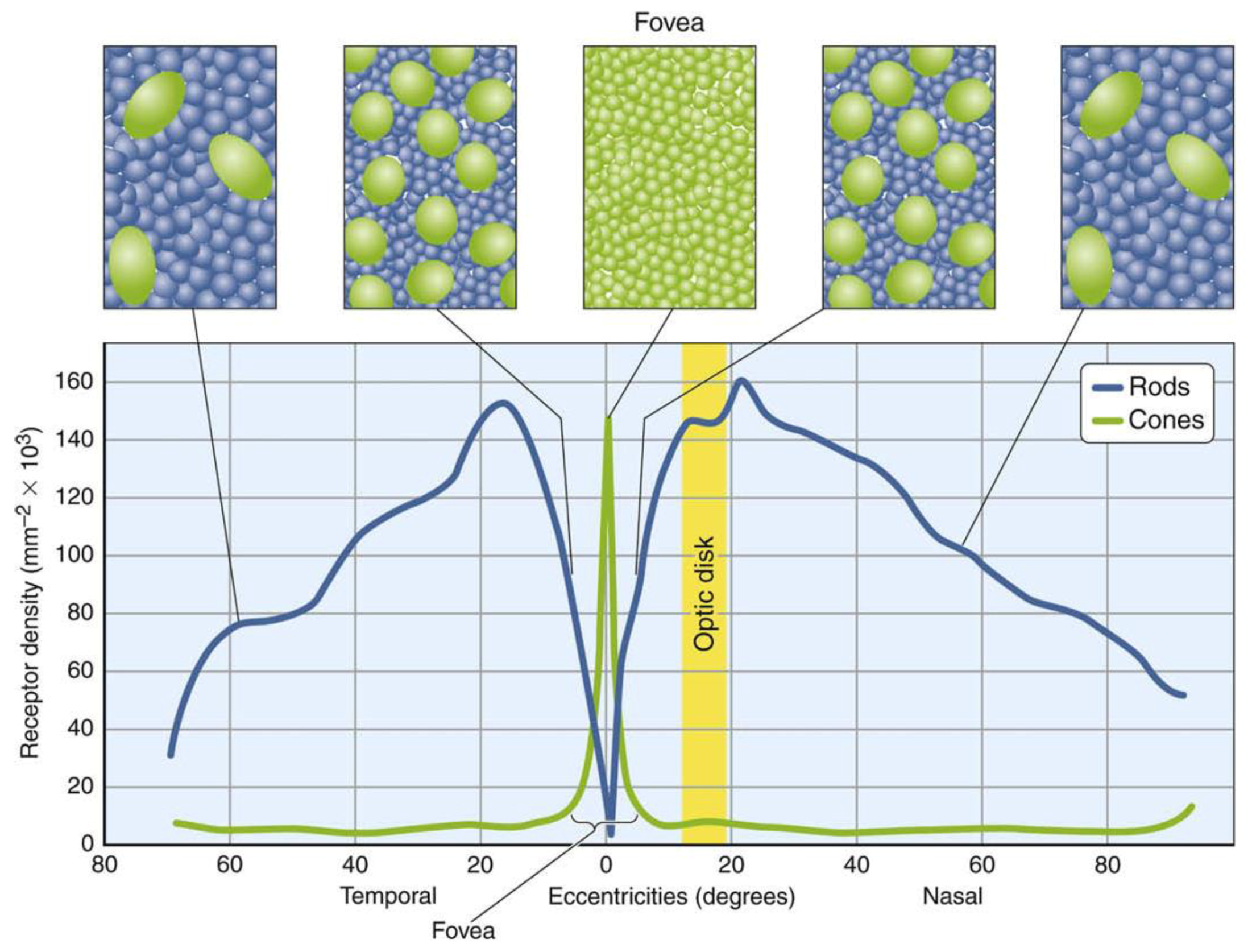
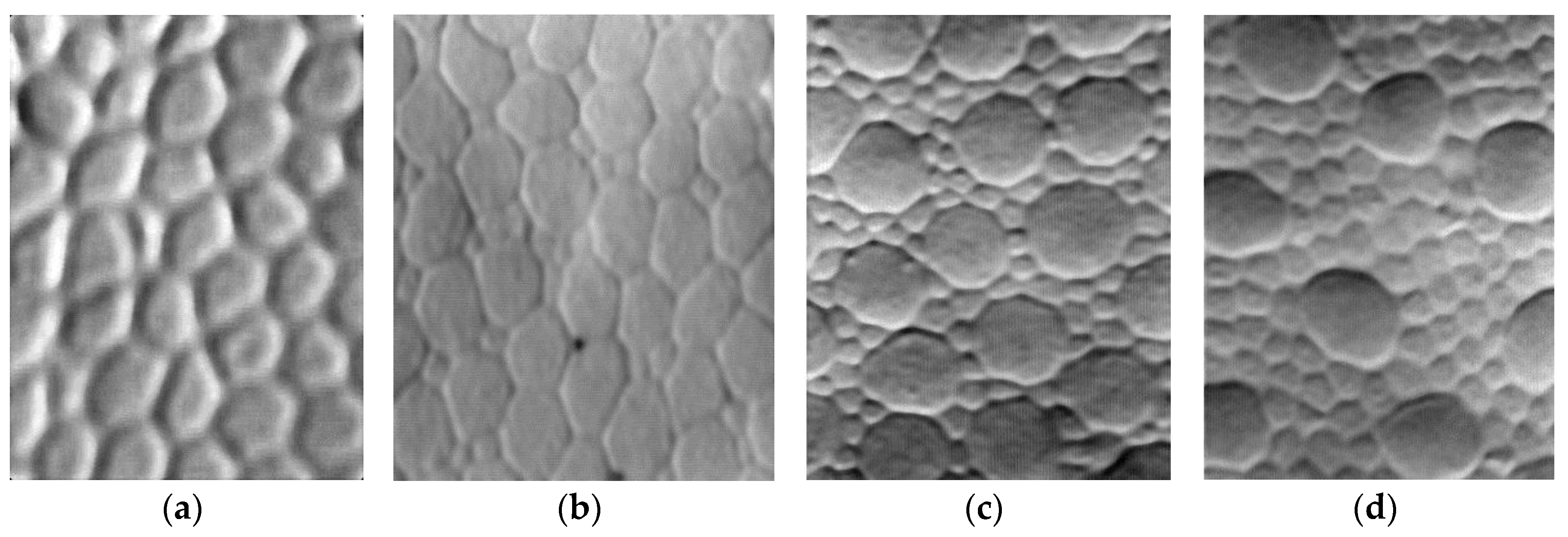
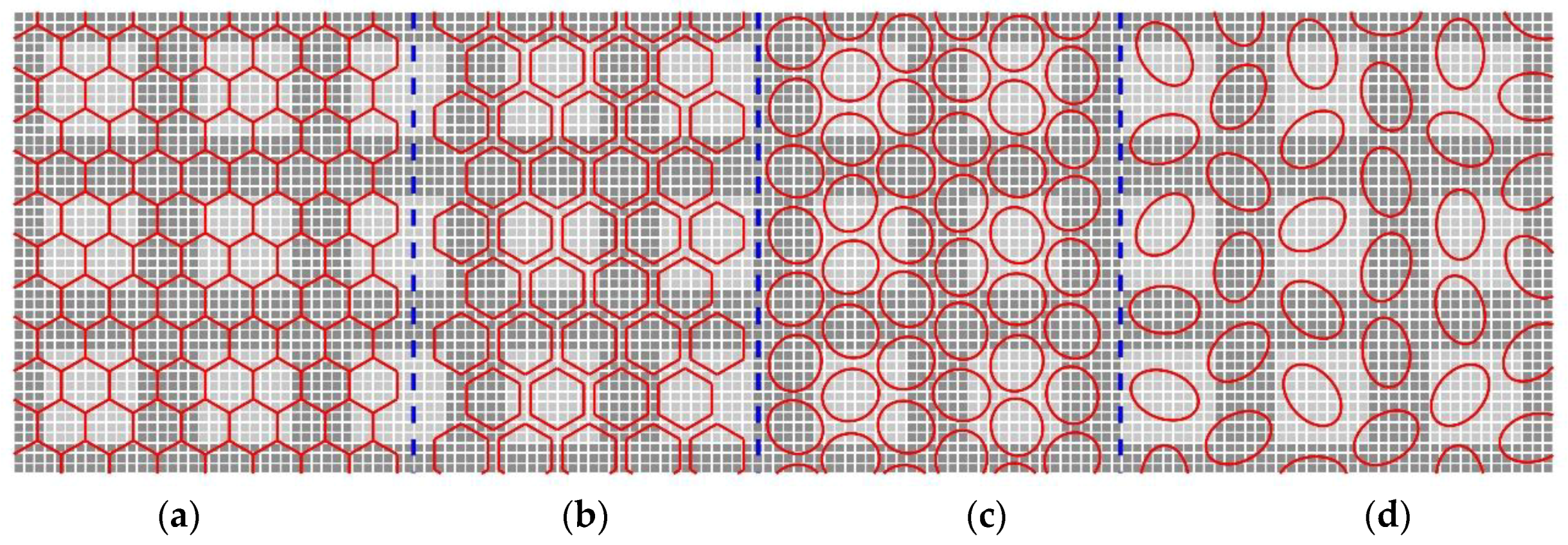
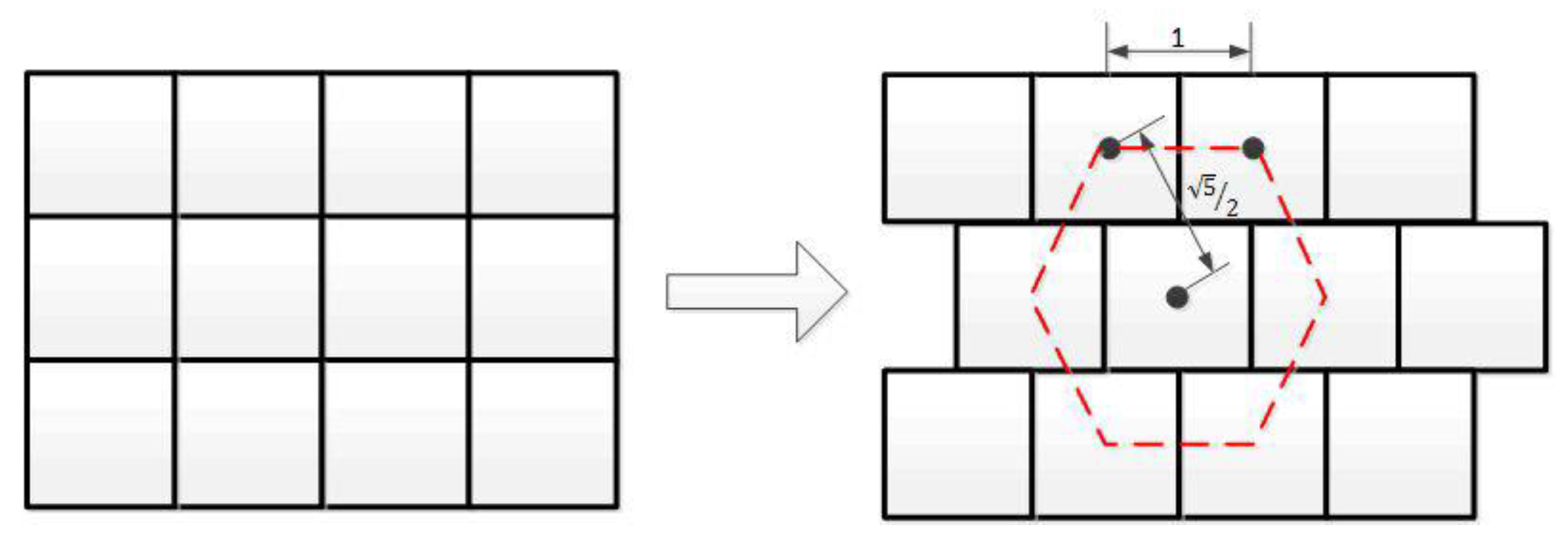
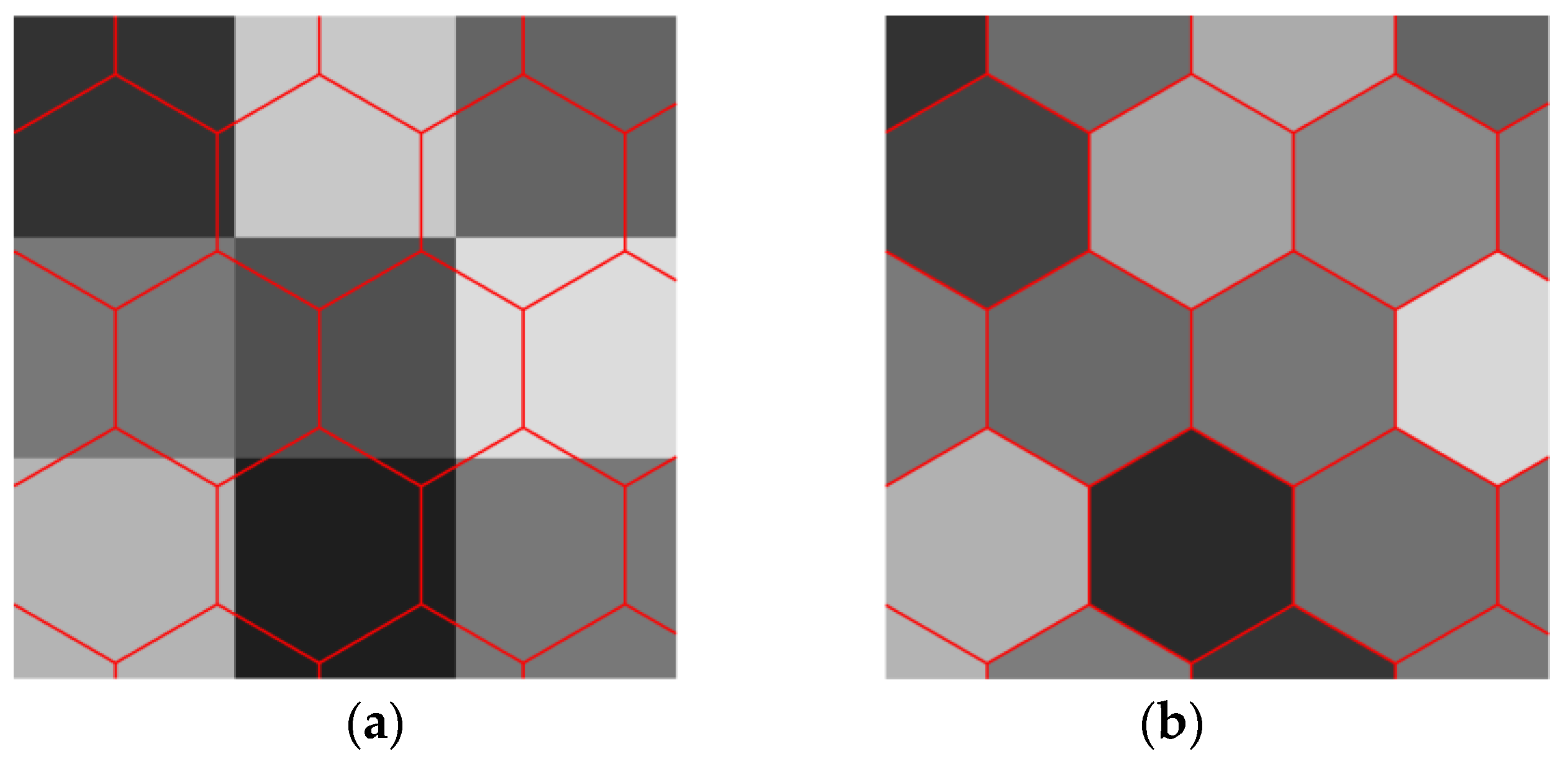
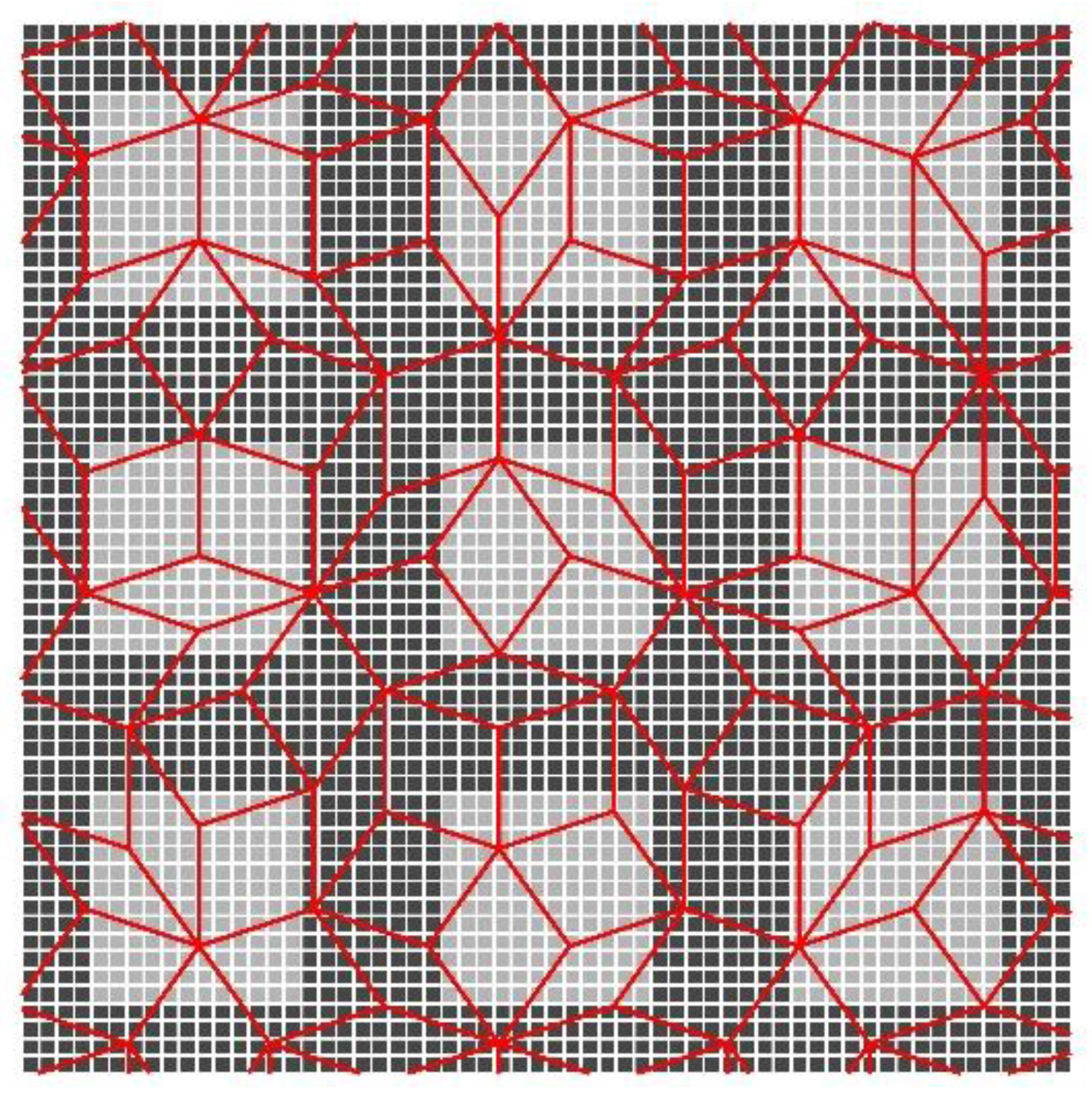


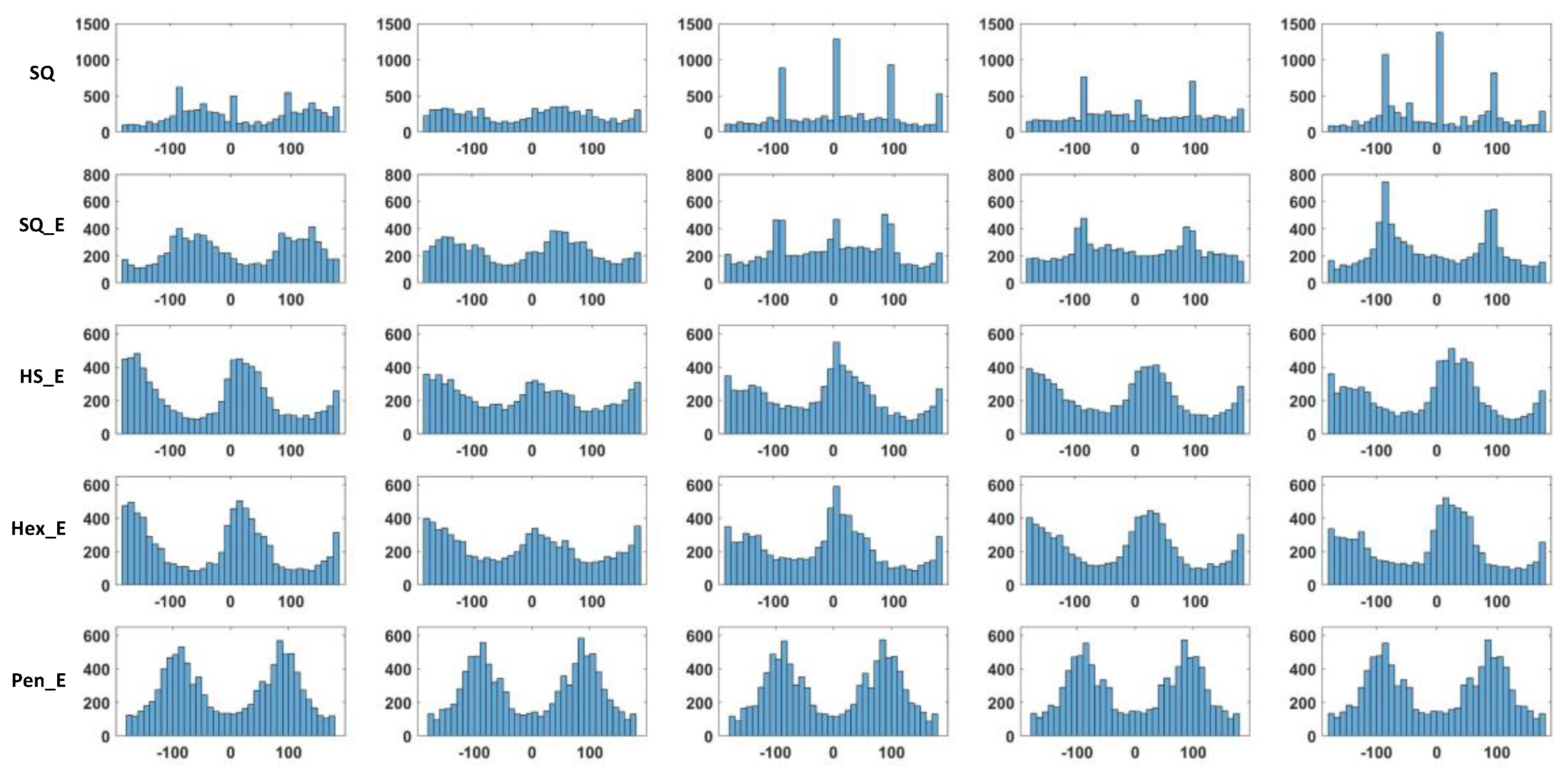
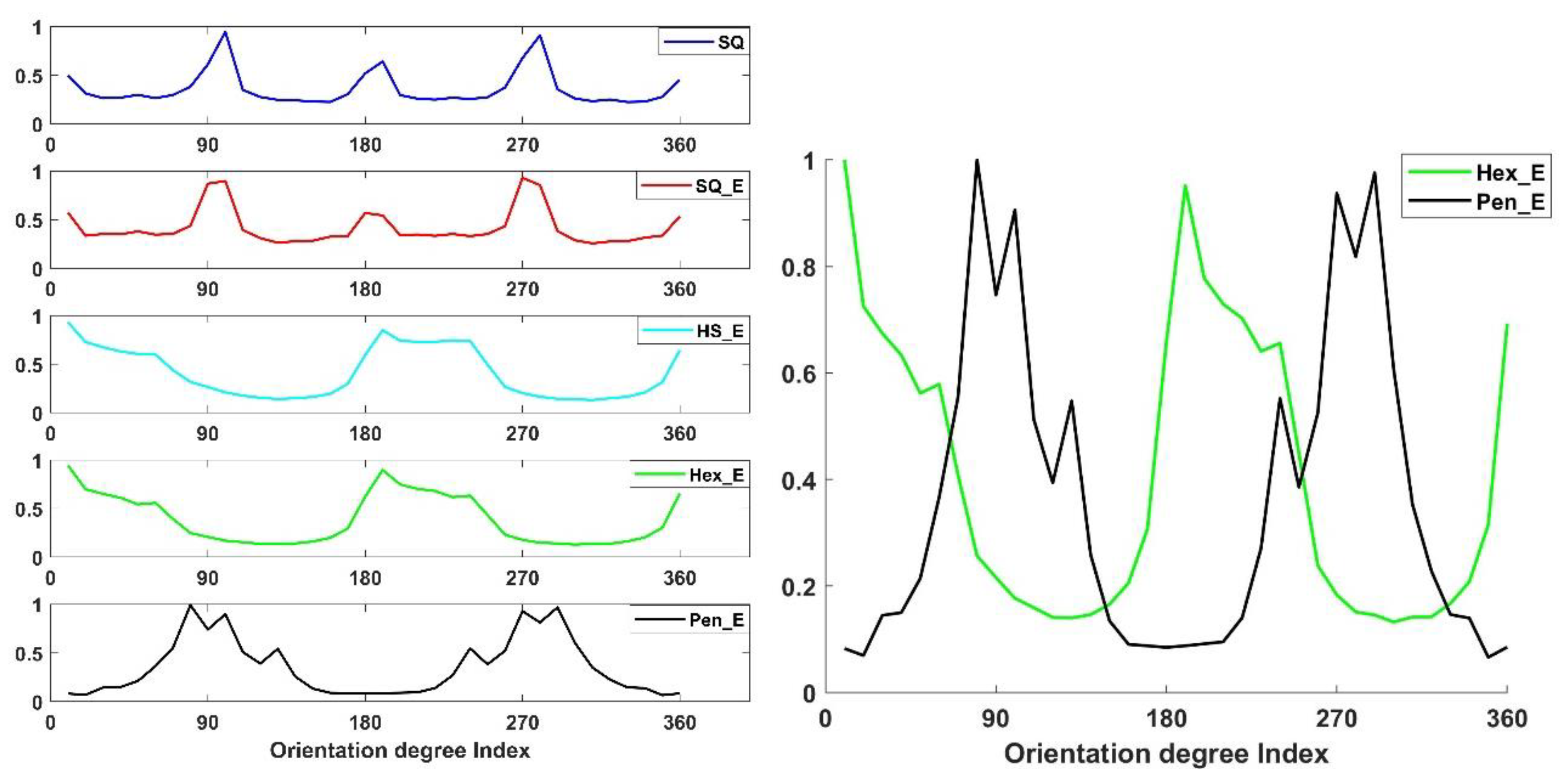
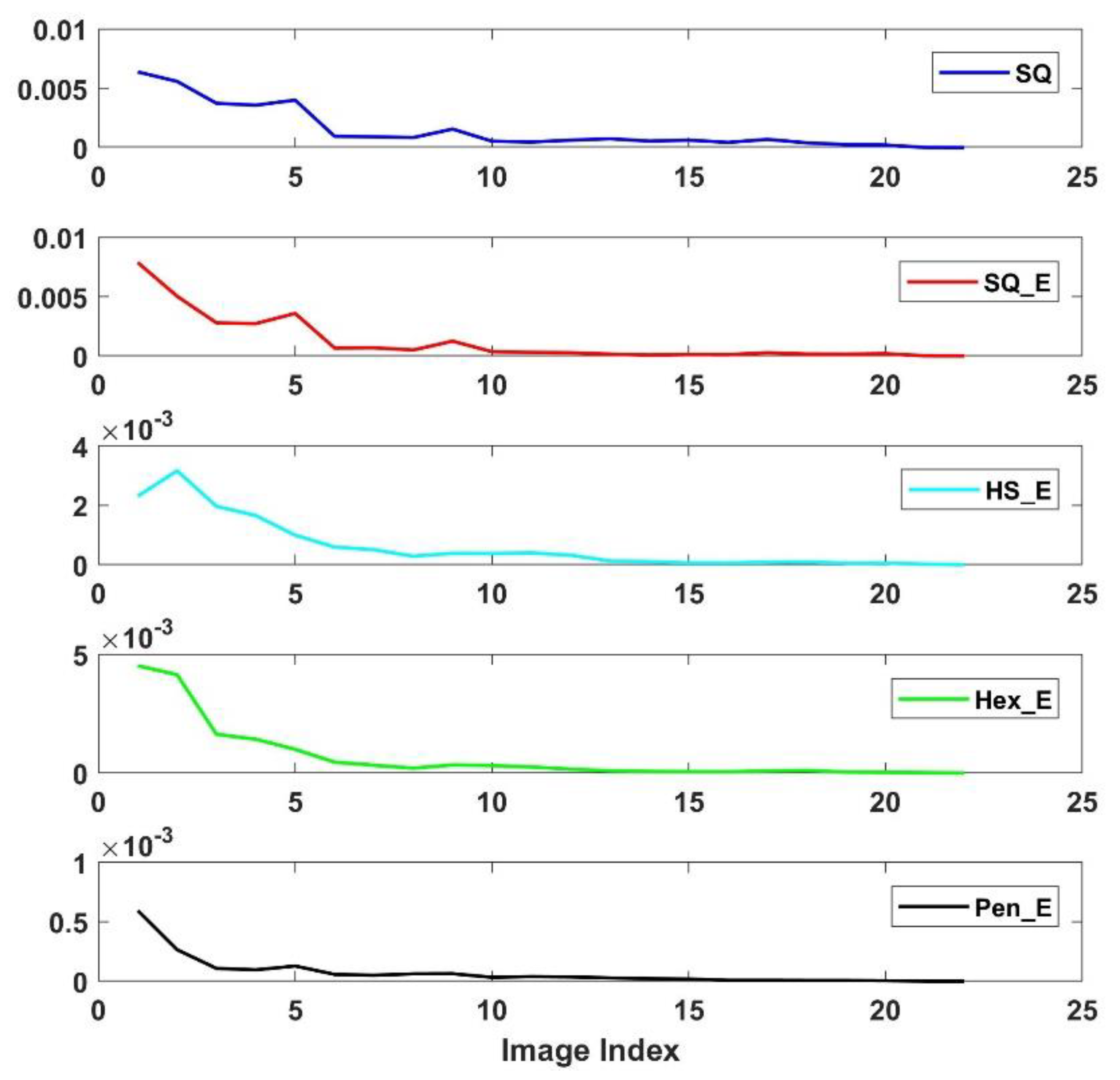
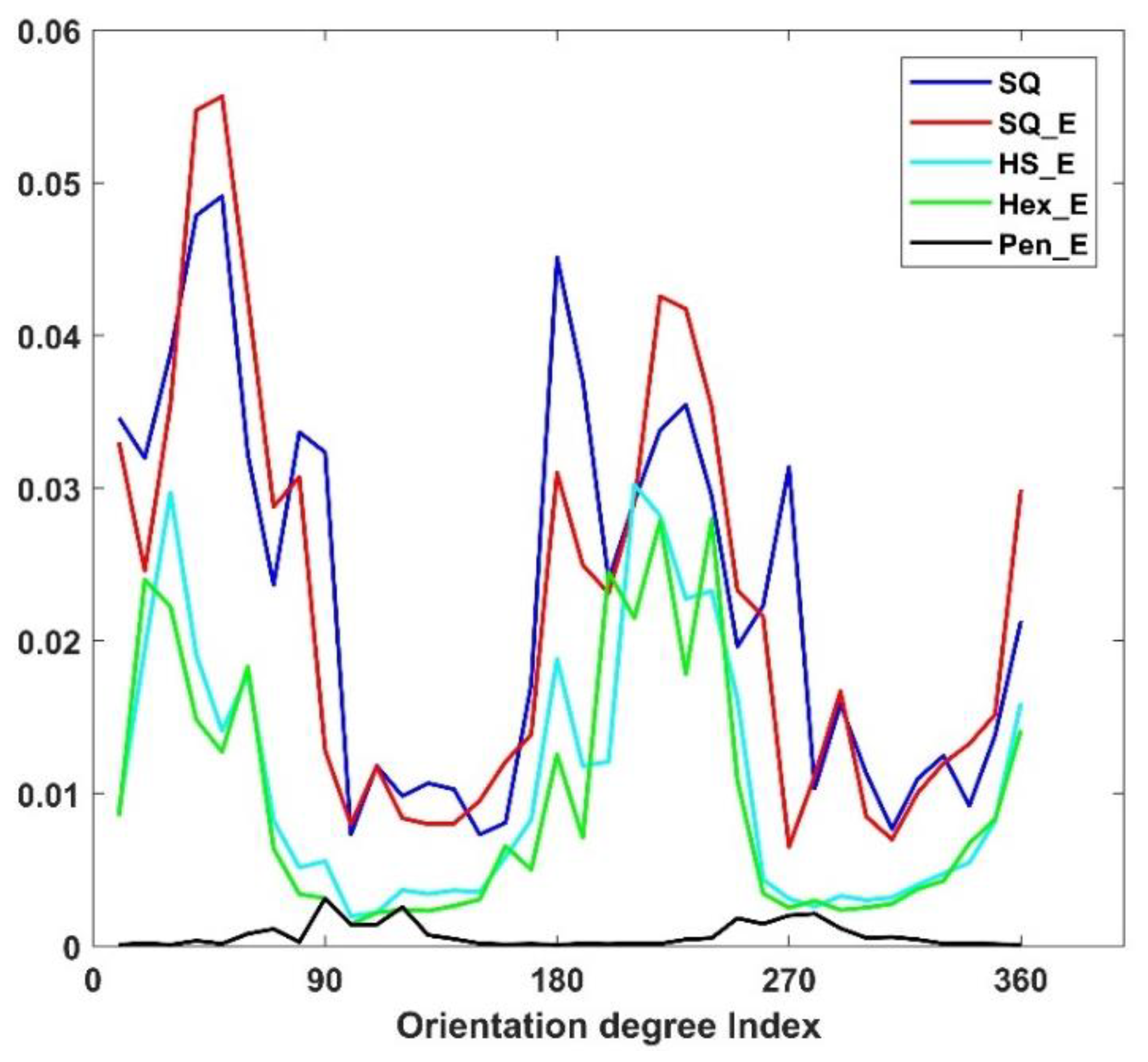



| Referred to 0% Gap Factor | ||||
|---|---|---|---|---|
| Gap Factor | SQ_E | HS_E | Hex_E | Pen_E |
| 60% | 0.0052 | 0.0059 | 0.0078 | 0.0004 |
| 40% | 0.0049 | 0.0029 | 0.0053 | 0.00035 |
| 20% | 0.0050 | 0.0028 | 0.0034 | 0.0003 |
| Referred to 0% Gap Factor | ||||
|---|---|---|---|---|
| Gap factor | SQ_E | HS_E | Hex_E | Pen_E |
| 0% | 0.0039 | 0.0308 | 0.0271 | 0.0036 |
| Correlation to SQ | ||||||||||||
|---|---|---|---|---|---|---|---|---|---|---|---|---|
| SQ_E | HS_E | Hex_E | Pen_E | |||||||||
| No. | Size 4 | Size 8 | Size 16 | Size 4 | Size 8 | Size 16 | Size 4 | Size 8 | Size 16 | Size 4 | Size 8 | Size 16 |
| 1 | 0.593 | 0.799 | 0.9 | 0.123 | 0.097 | 0.071 | 0.096 | 0.072 | 0.04 | 0.064 | 0.072 | 0.163 |
| 2 | 0.679 | 0.818 | 0.907 | 0.258 | 0.289 | 0.341 | 0.27 | 0.309 | 0.369 | 0.064 | 0.074 | 0.106 |
| 3 | 0.627 | 0.819 | 0.911 | 0.155 | 0.164 | 0.239 | 0.149 | 0.18 | 0.267 | 0.001 | 0.035 | 0.081 |
| 4 | 0.672 | 0.809 | 0.886 | 0.066 | 0.131 | 0.167 | 0.053 | 0.12 | 0.132 | 0.081 | 0.114 | 0.173 |
| 5 | 0.648 | 0.817 | 0.929 | 0.101 | 0.156 | 0.097 | 0.108 | 0.145 | 0.107 | 0.029 | 0.062 | 0.072 |
| 6 | 0.676 | 0.862 | 0.947 | 0.074 | 0.124 | 0.15 | 0.066 | 0.128 | 0.15 | 0.042 | 0.14 | 0.232 |
| 7 | 0.623 | 0.822 | 0.903 | 0.022 | 0.111 | 0.229 | 0.056 | 0.126 | 0.204 | 0.012 | 0.015 | 0.067 |
| 8 | 0.634 | 0.824 | 0.912 | 0.082 | 0.138 | 0.107 | 0.087 | 0.133 | 0.113 | 0.05 | 0.089 | 0.121 |
| 9 | 0.65 | 0.834 | 0.918 | 0.01 | 0.019 | 0.075 | 0.018 | 0.007 | 0.084 | 0.018 | 0.076 | 0.171 |
| 10 | 0.652 | 0.858 | 0.951 | 0.008 | 0.006 | 0.14 | 0.004 | 0.002 | 0.158 | 0.164 | 0.243 | 0.368 |
| 11 | 0.633 | 0.802 | 0.907 | 0.026 | 0.042 | 0.045 | 0.032 | 0.059 | 0.058 | 0.012 | 0.054 | 0.126 |
| 12 | 0.604 | 0.828 | 0.912 | 0.039 | 0.086 | 0.078 | 0.053 | 0.096 | 0.045 | 0.026 | 0.027 | 0.105 |
| 13 | 0.634 | 0.815 | 0.893 | 0.146 | 0.216 | 0.143 | 0.145 | 0.217 | 0.171 | 0.037 | 0.08 | 0.047 |
| 14 | 0.613 | 0.789 | 0.88 | 0.122 | 0.19 | 0.154 | 0.129 | 0.189 | 0.165 | 0.006 | 0.007 | 0.01 |
| 15 | 0.629 | 0.821 | 0.877 | 0.053 | 0.051 | 0.001 | 0.065 | 0.038 | 0.006 | 0.013 | 0.038 | 0.111 |
| 16 | 0.644 | 0.81 | 0.896 | 0.098 | 0.111 | 0.002 | 0.094 | 0.093 | 0.012 | 0.039 | 0.063 | 0.179 |
| 17 | 0.587 | 0.79 | 0.889 | 0.118 | 0.171 | 0.072 | 0.141 | 0.176 | 0.122 | 0.01 | 0.045 | 0.017 |
| 18 | 0.612 | 0.766 | 0.882 | 0.063 | 0.083 | 0.108 | 0.036 | 0.064 | 0.06 | 0.096 | 0.166 | 0.256 |
| 19 | 0.647 | 0.809 | 0.902 | 0.063 | 0.133 | 0.112 | 0.07 | 0.124 | 0.117 | 0.036 | 0.026 | 0.027 |
| 20 | 0.602 | 0.796 | 0.885 | 0.186 | 0.26 | 0.275 | 0.187 | 0.268 | 0.284 | 0.009 | 0.013 | 0.001 |
| 21 | 0.636 | 0.789 | 0.912 | 0.027 | 0.037 | 0.002 | 0.029 | 0.037 | 0.039 | 0.09 | 0.175 | 0.234 |
| 22 | 0.596 | 0.795 | 0.885 | 0.024 | 0.055 | 0.079 | 0.034 | 0.045 | 0.042 | 0.008 | 0.018 | 0.066 |
| 23 | 0.642 | 0.819 | 0.894 | 0.074 | 0.113 | 0.17 | 0.072 | 0.115 | 0.132 | 0.058 | 0.038 | 0.015 |
© 2018 by the authors. Licensee MDPI, Basel, Switzerland. This article is an open access article distributed under the terms and conditions of the Creative Commons Attribution (CC BY) license (http://creativecommons.org/licenses/by/4.0/).
Share and Cite
Wen, W.; Khatibi, S. Virtual Deformable Image Sensors: Towards to a General Framework for Image Sensors with Flexible Grids and Forms. Sensors 2018, 18, 1856. https://doi.org/10.3390/s18061856
Wen W, Khatibi S. Virtual Deformable Image Sensors: Towards to a General Framework for Image Sensors with Flexible Grids and Forms. Sensors. 2018; 18(6):1856. https://doi.org/10.3390/s18061856
Chicago/Turabian StyleWen, Wei, and Siamak Khatibi. 2018. "Virtual Deformable Image Sensors: Towards to a General Framework for Image Sensors with Flexible Grids and Forms" Sensors 18, no. 6: 1856. https://doi.org/10.3390/s18061856





